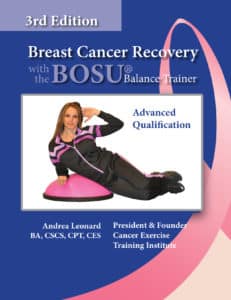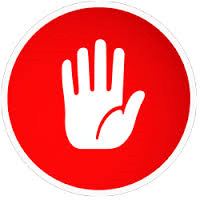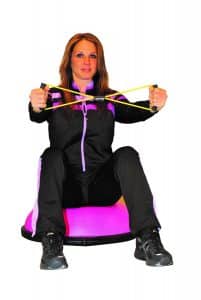One of the most important, if not THE most important part of recovery from the debilitating side-effects of breast cancer surgery and treatment is correcting postural deviations that are the result of muscle imbalances. We must re-educate the body to restore its’ normal balance. Most of us think of balance as one’s ability to stand without falling, but it actually represents the ability to stabilize and maintain a specific body position. Postural control is defined as the act of maintaining, achieving, or restoring a state of balance during any posture or activity. Therefore, it only makes sense that performing exercises to correct range of motion and postural deviations, while incorporating the aspect of balance, would yield the greatest results!
As individuals, we all have varying levels of kinesthetic awareness: sensitivity to the moment of your body through space that contributes to your ability to balance and move rhythmically and fluidly. This can be affected by many things; age, previous injuries, athleticism, and neuropathy. A fairly common side-effect of chemotherapy is peripheral neuropathy. Peripheral nerves carry information to and from the brain and carry signals to and from the spinal cord to the rest of the body. Peripheral neuropathy means these nerves don’t work properly. Peripheral neuropathy may be damage to a single nerve, or a group of nerves. Typical symptoms of neuropathy are related to the type of affected nerve. If a sensory nerve is damaged, common symptoms include numbness, tingling in the area, a prickling sensation, or pain. Pain associated with neuropathy can range from a mild burning to an intense stabbing sensation. In some cases, a non-painful stimulus may be perceived as excruciating or pain may be felt even in the absence of a stimulus. Damage to a motor nerve is usually indicated by weakness in the affected area. If the problem with the motor nerve has continued over a length of time, muscle shrinkage, or lack of muscle tone may be noticeable.
This brings us to another very important aspect of balance and performance, proprioception. Proprioception is the ability to sense the position, location, orientation, and movement of the body and its parts. You can see how this could become challenging to someone who is affected by peripheral neuropathy and either loses sensation in their extremities, or is fraught with constant pain in that area.
If your client has peripheral neuropathy in their hands, they may find it very difficult to articulate exercises that involve the use of weights or resistance bands. You can avoid those exercises and focus on the many exercises that do not require an external load to be placed on the muscles. If they have peripheral neuropathy in their feet, it is not advisable to perform high impact activities. That being the case, when bouncing on the BOSU® Balance Trainer, make sure that their feet remain in contact with the dome and instruct them to stop if their pain increases; or they feel unsteady due to lack of sensation in their feet. Peripheral neuropathy may be temporary or, in some cases, chronic. Your client should listen to their body and respect whatever limitations it may place on them in a given day. Remember that you can still advance and help them work towards both their short-term and long-term personal fitness goals.
Exercising on the BOSU® Balance Trainer is going to help them to increase their postural stability; their ability to maintain the position of their body, or more specifically, it’s’ center of mass, within specific boundaries of space. This, too, is one of the many benefits of working on the BOSU® Balance Trainer. Many of your clients may be menopausal either from the natural aging process, or, from the early onset of menopause due to their breast cancer treatment(s). This will result in the cessation of estrogen production which increases their risk of osteoporosis; reduction in bone mineral density. Not only will they increase their bone density by performing many of the weight-bearing exercises in this handbook, they will be constantly working on their balance and core stability which will dramatically reduce their risk of falling! Additionally, they will be strengthening the tendons and ligaments that are a vital part of ankle stabilization.
In summary, exercising on the BOSU® Balance Trainer is going to have some, if not all, of the following benefits:
- increase kinesthetic awareness, proprioception, and postural stability
- increase bone density/reduce the risk of osteoporosis
- increase balance/minimize your risk of falling and breaking a bone
- strengthen ligaments and tendons of ankle complex/reduce risk of sprains and strains
- increase aerobic capacity
- increase lymphatic drainage (by gently bouncing on the BOSU® Balance Trainer)
- increase core strength/minimize low back pain
- correct postural deviations/reduce pain and joint degeneration
- increase range of motion
- improve functional fitness and the ability to perform activities of daily living
Here are some beginning exercises progressions for you to try with your clients who are at least 6 weeks post-op and have a medical clearance from their physician:

If your client has undergone a unilateral TRAM Flap (only one side of their rectus abdominis has been sacrificed) they may need minor assistance in lowering themselves back onto the BOSU® Balance Trainer. On the other hand, if it is a bi-lateral Tram Flap, they will NOT be able to roll backwards or subsequently roll themselves back to an upright position without assistance. You may help them with this motion, or instruct them to roll onto their side in order to get “in to” and “out of” the position.
There may come a point at which your client can perform this stretch and not feel a “stretch” any longer. While this is a positive outcome, do not take your client’s newly discovered “flexibility’ for granted. More often than not, without continued practice, the client will gradually lose the newly acquired flexibility and/or ROM. Therefore it is essential, that they continue with this stretch at least periodically, into perpetuity.
Chest Expansion
Level 1 – Have your client sit upright on a chair with knees bent and both arms bent behind their head (palms face the head). Instruct them to gently expand their chest and simultaneously contract their shoulder blades; until they feel a gentle stretching sensation. Hold for 15-30 seconds, or as long as they can without pain. This can also be done with continuous movement; trying to go a bit further each time.
For the client who is ready for a greater balance challenge, have them try to minimize contact with the floor by lifting one foot off of the floor, but maintaining contact with the toes. Next have them try to eliminate all contact with one foot. Progress/regress as needed for the individual’s fitness level.
When the client is confident and can perform Level 1 Chest Expansion pain-free, they may progress to Level 2 Chest Expansion on the BOSU® Balance Trainer.
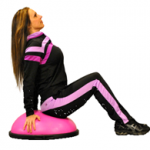
For the client who is ready for a greater balance challenge, have them try to minimize contact with the floor by lifting one foot off of the floor, but maintaining contact with the toes. Next have them try to eliminate all contact with one foot. Progress/regress as needed for the individual’s fitness level.
If the client is struggling, or in pain, please go back to Level 1 Chest Expansion. After performing Level 1 Chest Expansion on several occasions, pain free, try Level 2 Chest Expansion on the BOSU® Balance Trainer again.
When the client is confident and can perform Level 2 Chest Expansion on the BOSU® Balance Trainer pain-free, they may progress to Level 3 Chest Expansion on the BOSU® Balance Trainer

Have them start by raising their arms straight up towards the ceiling with their palms facing each other. Instruct them to bend their elbows slightly; as if hugging a barrel. They should allow their arms to slowly lower outward and toward the floor while maintaining a slight bend in their elbows. Hold for 15-30 seconds or as long as they can without pain. This can also be done with continuous movement; trying to go a bit further each time.
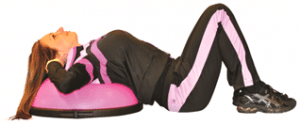
For the client who is ready for a greater balance challenge, have them try to minimize contact with the floor by lifting one foot off of the floor, but maintaining contact with the toes. Next have them try to eliminate all contact with one foot. Progress/regress as needed for the individual’s fitness level.
If the client is struggling, or in pain, please go back to Level 2 Chest Expansion on the BOSU® Balance Trainer. After performing Level 2 Chest Expansion on the BOSU® Balance Trainer several occasions, pain free, try Level 3 Chest Expansion on the BOSU® Balance Trainer again.
Newton’s Third Law of Physics states that for every action there is an equal and opposite reaction. In the fitness world this is known as reciprocal inhibition. In simple terms, if your chest muscles are contracted, the opposing back muscles have no option other than to stretch. Therefore, if we want to stretch the chest muscles, we must contract and strengthen the back muscles. The following exercises are designed to do just that. Because we are adding resistance to the exercises, you will want to have your clients begin with the lightest resistance band possible and perform only a few repetitions. There are two things that you are looking for in terms of their body’s response to these exercises. The first is that they are not in pain, beyond slight muscle soreness, the next day. The second is that there is no swelling in their affected arm that could suggest the onset of lymphedema. If they end up uncomfortably sore the next day, you were probably a bit ambitious and should use less resistance or no resistance (just go through the motions without a band or weights). If they have any noticeable swelling when they perform the “pitting” test, have them stop exercising, see their doctor, and make sure that they return with a medical clearance form giving them permission to resume exercising. Make sure to begin with fewer repetitions and lighter resistance this time around and carefully monitor to make sure there is not an increase in swelling. If they are given a sleeve to wear, it is imperative that you require it during their exercise session.
Precautions: If your client has expanders or breast implants, you will want to have them begin with limited ROM simply using an isometric contraction without using the band. It is rare, but possible, that the implants will move out of their “pocket,” and need surgical correction.
If your client has undergone a LAT Flap, they will have noticeable weakness and instability in the affected shoulder. Teach them how to retract their shoulders prior to initiating the movement. This will help them to contract their rhomboids and other scapular stabilizers. Keep in mind that one, or both, of their latissimus muscles are now in their chest wall. Because they are still “attached,” they may feel a contraction in their chest when back exercises are performed. This is one of the many reasons why it is important to focus on the smaller scapular stabilizers of the back.
If your client has undergone a TRAM Flap, this is a fantastic opportunity to educate them on how to engage their spinal stabilizers and core musculature. Watch for excessive arching in the lower back. If they complain of low back pain, more attention should be paid to core “education” and exercises.
If your client has had lymph nodes removed or irradiated, it is CRITICAL that they do not wrap exercise bands around their affected arm as it may restrict circulation and bring on lymphedema. It will also be imperative that they begin with minimal repetitions and little to no resistance, making sure there is no swelling in the affected arm following each session. If there is no sign of swelling they can gradually add more repetitions and greater resistance.
If your client has peripheral neuropathy in their hands, do not use a band or hand weights when performing the exercise.
Reverse Fly
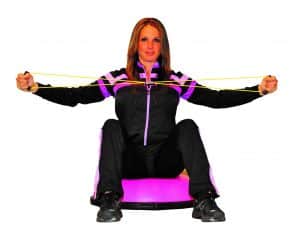
Level 1 – This version of the reverse fly is an easier position for someone who has undergone a TRAM flap and has difficulty lowering themselves to the floor. The beginner should attempt this exercise sitting in a chair with no resistance to begin with. Instruct them to exhale, retract their shoulder blades, and simultaneously expand their chest as they open their arms out to the side (reverse barrel hug). Have them pause 1-2 seconds, inhale, and slowly return to starting position.
For the client who is ready for a greater balance challenge, have them try to minimize contact with the floor by lifting the toes of the right foot off of the floor and holding that position for several seconds. Have them alternate lifting their right and then left foot off of the ground. When they are confident and stable, have them try lifting both feet off of the ground. Progress/regress as needed for the individual’s fitness level.
Perform only a few repetitions with no resistance initially and make sure there is no swelling in the affected arm in the days to come. If there is no sign of swelling you can gradually add more repetitions and greater resistance.
When the client is confident and stable at Level 1 Reverse Fly on the BOSU® Balance Trainer, they may progress to Level 2 Reverse Fly on the BOSU® Balance Trainer.
Level 2 – The client should begin this exercise sitting upright in the center of the BOSU® Balance Trainer with both feet (sets of toes) in contact with the floor for maximum stability. Have them hold their arms straight out in front of them (parallel to the floor with palms facing each other) holding one end of an exercise band in each hand. Instruct them to exhale, expand their chest, and simultaneously squeeze their shoulder blades together as they pull the band out to their sides (make sure they keep a slight bend in their elbows throughout the motion Have them pause 1-2 seconds, inhale, and slowly return to starting position.
For the client who is ready for a greater balance challenge, have them try to minimize contact with the floor by lifting one foot off of the floor, but maintaining contact with the toes. Next have them try to eliminate all contact with one foot. Progress/regress as needed for the individual’s fitness level.
If the client is struggling, please go back to the Level 1 Reverse Fly. After performing the Level 1 Reverse Fly on several occasions, try Level 2 Reverse Fly on the BOSU® Balance Trainer again. When the client is confident and stable at Level 2 Reverse Fly on the BOSU® Balance Trainer, they may progress to Level 3 Reverse Fly on the BOSU® Balance Trainer.
When the client is confident and stable at Level 2 Reverse Fly on the BOSU® Balance Trainer, they may progress to Level 3 Reverse Fly on the BOSU® Balance Trainer.
Level 3 – The client should begin this exercise standing in the center of the BOSU® Balance Trainer with both feet (sets of toes) in contact with the BOSU® Balance Trainer for maximum stability. Have them hold their arms straight out in front of them (parallel to the floor with palms facing each other) holding one end of an exercise band in each hand. Instruct them to exhale, expand their chest, and simultaneously squeeze their shoulder blades together as they pull the band out to their sides (make sure they keep a slight bend in their elbows throughout the motion). Have them pause 1-2 seconds, inhale, and slowly return to starting position.
For the client who is ready for a greater balance challenge, have them try to minimize contact with the floor by lifting one foot off of the BOSU® Balance Trainer, but maintaining contact with the toes. Next have them try to eliminate all contact with one foot. Progress/regress as needed for the individual’s fitness level.
If the client is struggling, please go back to Level 2 Reverse Fly on the BOSU® Balance Trainer. After performing the Level 2 Reverse Fly on the BOSU® Balance Trainer while on several occasions, try Level 3 Reverse Fly on the BOSU® Balance Trainer again.
